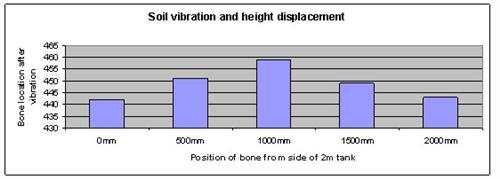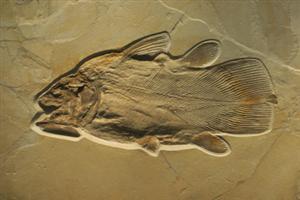| Complexity level: | 5 |
| Project cost ($): | 60 |
| Time required: | 2 hours for preparation, 1 hour for experiment |
| Material availability: | Easily found. Fish tanks can be purchased from a pet store |
| Safety concerns: | None |
Hypothesis
The bone located in the middle of the container, which simulates the centre of a seismic zone, will experience the greatest vertical displacement.
Overview
Vibration convection
Vibration convection occurs when granulated material like soil is subjected to seismic tremors or vibrations under the gravitational field. This causes the finer grains in soil to move downwards, while larger particles end up on top.
When a container of soil accelerates upwards due to seismic activity, its base lifts the entire mass of soil upwards. However, when the container falls back downwards due to gravity, friction between the sides of the container and the soil will also pull the soil down with the container. In this case, the soil nearer the sides of the container will fall more quickly than the soil in the middle of the container, causing the latter to appear to be raised.
Vibrations will also cause the lateral movement of grains in soil. This movement will cause collisions to occur between neighboring granules, which will then liquefy the soil. In turn, the soil will start moving and gain velocity.
Scientific Terms
Materials
The materials required for the science fair project:
- 1 transparent fish tank of dimensions 2m x 1m x 1m
- 5 dried chicken drumstick bones
- Loam soil (enough to fill the fish tank up to a height of 750mm)
- Table to support the fish tank
- 1 stopwatch
- 1 metal rod (or metal ruler)
- 1 ruler
- 1 black marker
Procedure
1. For this science fair project, the independent variable is the environment which will simulate the earthquake zone, which will be a fish tank filled with soil and water. The dependent variable is the vertical displacement of the bones after being subjected to vibration. This is determined by measuring the height of the bones in the soil after applying the vibration. The constants (control variables) are the size of the fish tank, the type of soil used, the size of the bones, the initial height of the bones in the soil and the length of time of the vibration.
2. Place the fish tank on a table. Add soil into the tank until the height of the soil reaches 500mm. Slowly pour 1 liter of tap water over the soil, ensuring that the soil surface stays even.
3. Starting from the left side of the tank, position 5 chicken drumstick bones at the distances of 0mm, 500mm, 1000mm, 1500mm and 2000mm from the left wall of the tank. The last bone will be next to the right side of the tank.
4. Add more soil over the bones until a soil height of 750mm is reached. Slowly pour another 500ml of tap water over the surface of the soil, ensuring the soil surface stays even. Leave the tank on the table for 1 hour for everything to settle.
5. With the help of 2 assistants, shake the table with the fish tank on it for 10 minutes. Ensure that the vibratory movements are both lateral and vertical.
6. Slowly remove the soil, layer by layer, with minimal disturbance to the bones. Once each bone is reached, insert the metal rod into the soil until it touches the bottom of the tank. With the black marker, indicate on the metal rod the depth at which the bone was found. Record the depths for the 5 bones in a table, as shown below.

Results
The results show that the bones located near the tank walls had the highest displacement. The bone near the center of the tank had the least downward displacement.
| Bone location from left side | Height of bone after 10 minutes vibration (mm) | ||||
| 0mm | 500mm | 1000mm | 1500mm | 2000mm | |
| Height | 442 | 451 | 459 | 449 | 443 |
The above results are represented in a chart below:

Conclusion
The hypothesis that the bone located in the middle of the container will have the most vertical displacement has not been proven to be true.
Vibrations caused by an earthquake causes grains in the soil to become compacted as water between the grains is expelled. The expelling of water, together with vibration, causes soil to behave like liquid. This process, which is known as liquefaction, creates landslides and undermines the foundations of buildings, causing them to collapse.
Also consider
The science fair project may be modified to test which soil varieties are most susceptible to liquefaction, by using different types of soil, such as sand and clay.
The experiment may also be modified to test the displacement of materials of different density and sizes.
References
Convection - http://wapedia.mobi/en/Convection#7.
Facts about quicksand - http://www.dellamente.com/quicksand/doc/qsfacts.htm
Vibrations of granular material - http://thesis.library.caltech.edu/4504/

